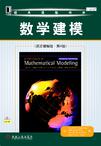数学建模
出版时间:2009-10 出版社:机械工业出版社 作者:Frank R. Giordano,William P. Fox,Steven B. Horton,Maurice D. Weir 页数:454
Tag标签:无
前言
To facilitate an early initiation of the modeling experience, the first edition of this text was designed to be taught concurrently or immediately after an introductory business or engineering calculus course. In the second edition, we added chapters treating discrete dynamical systems, linear programming and numerical search methods, and an introduction to probabilistic modeling. Additionally, we expanded our introduction of simulation. In the third edition we included solution methods for some simple dynamical systems to reveal their long-term behavior. We also added basic numerical solution methods to the chapters covering modeling with differential equations. In this edition, we have added a new chapter to address modeling using graph theory. Graph theory is an area of burgeoning interest tor modeling contemporary scenarios. Our chapter is intended to introduce graph theory from a modeling perspective and encourage students to pursue the subject in greater detail. We have also added two new sections to the chapter on modeling with a differential equation: discussions of separation of variables and linear equations. Many of our readers had expressed a desire that analytic solutions to first-order differential equations be included as part of their modeling course. The text has been reorganized into two parts: Part One,Discrete Modeling (Chapters 1-9), and Part Two, Continuous Modeling (Chapters 10-13). This organizational structure allows for teaching an entire modeling course that is based on Part One and does not require the calculus. Part Two then addresses continuous models based on optimization and differential equations that can be presented concurrently with freshman calculus. The text gives students an opportunity to cover all phases of the mathematical modeling process. The new CD-ROM accompanying the text contains software, additional modeling scenarios and projects, and a link to past problems from the Mathematical Contest in Modeling. We thank Sol Garfunkel and the COMAP staff for their support of modeling activities that we refer to under Resource Materials below. . Goals and Orientation The course continues to be a bridge between the study of mathematics and the applications of mathematics to various fields. The course affords the student an early opportunity to see how the pieces of an applied problem fit together. The student investigates meaningful and practical problems chosen from common experiences encompassing many academic disciplines, including the mathematical sciences, operations research, engineering, and the management and life sciences. This text provides an introduction to the entire modeling process. Students will have opportunities to practice the following facets of modeling and enhance their problem-solving capabilities: 1. Creative and Empirical Model Construction: Given a real-world scenario, the student learns to identify a problem, make assumptions and collect data, propose a model, test the assumptions, refine the model as necessary, fit the model to data if appropriate, and analyze the underlying mathematical structure of the model to appraise the sensitivity of the conclusions when the assumptions are not precisely met. 2. Model Analysis: Given a model, the student learns to work backward to uncover the implicit underlying assumptions, assess critically how well those assumptions fit the scenario at hand, and estimate the sensitivity of the conclusions when the assumptions are not precisely met. 3. Model Research: The student investigates a specific area to gain a deeper understanding of some behavior and learns to use what has already been created or discovered. Student Background and Course Content Because our desire is to initiate the modeling experience as early as possible in the students program, the only prerequisite for Chapters 10, 11, and 12 is a basic understanding of single-variable differential and integral calculus. Although some unfamiliar mathematical ideas are taught as part of the modeling process, the emphasis is on using mathematics that the students already know after completing high school. This is especially true in Part One.The modeling course will then motivate students to study the more advanced courses such as linear algebra, differential equations, optimization and linear programming, numerical analysis, probability, and statistics. The power and utility of these subjects are intimated throughout the text. Further, the scenarios and problems in the text are not designed for the application of a particular mathematical technique. Instead, they demand thoughtful ingenuity in us-ing fundamental concepts to find reasonable solutions to "open-ended" problems. Certain mathematical techniques (such as Monte Carlo simulation, curve fitting, and dimensional analysis) are presented because often they are not formally covered at the undergraduate level. Instructors should find great flexibility in adapting the text to meet the particular needs of students through the problem assignments and student projects. We have used this material to teach courses to both undergraduate and graduate students——and even as a basis for faculty seminars.
内容概要
数学建模是用数学方法解决各种实际问题的桥梁。本书分离散建模和连续建模两部分介绍了整个建模过程的原理,通过本书的学习,学生将有机会在创造性模型和经验模型的构建、模型分析以及模型研究方面进行实践,增强解决问题的能力。 本书特点 论证了离散动力系统、离散优化等技术对现代应用数学发展的促进作用。 在创造性模型和经验模型的构建,模型分析以及模型研究中融入个人项目和小组项目,并且包含大量的例子和习题。 本版新增了关于图论建模的新的一章,从数学建模的角度介绍图论并鼓励学生对图论进行更深入的学习。 随书光盘中包含大学数学应用教学单元(UMAP),过去的建模竞赛试题,充满活力的跨学科应用研究课题,利用电子表格(Excel)、计算机代数系统(Maple、Mathematica、Matlab)以及图形计算器(TI)等技术的广泛的例子,在实验室环境下为学生设计的例子和习题。
作者简介
Frank R.Giordano毕业于美国西点军校,曾任西点军校数学系系主任,现为美国海军研究生院教授,多年来一直是美国大学生数学建模竞赛的主要组织者,也是美国大学生数学建模竞赛组委会主任。
书籍目录
1 Modeling Change Introduction 1.1 Modeling Change with Difference Equations 1.2 Approximating Change with DifferenceEquations 1.3 Solutions to Dynamical Systems 1.4 Systems of Difference Equations 2 The Modeling Process, Proportionality,and Geometric Similarity 2.1 Mathematical Models 2.2 Modeling Using Proportionality 2.3 Modeling Using Geometric Similarity 2.4 Automobile Gasoline Mileage 2.5 Body Weight and Height, Strength and Agility 3 Model Fitting 3.1 Fitting Models to Data Graphically 3.2 Analytic Methods of Model Fitting 3.3 Applying the Least-Squares Criterion 3.4 Choosing a Best Model 4 Experimental Modeling 4.1 Harvesting in the Chesapeake Bay and Other One-Term Models 4.2 High-Order Polynomial Models 4.3 Smoothing: Low-Order Polynomial Models 4.4 Cubic Spline Models5 Simulation Modeling Introduction 5.1 Simulating Deterministic Behavior: Area Under a Curve 5.2 Generating Random Numbers 5.3 Simulating Probabilistic Behavior 5.4 Inventory Model: Gasoline and Consumer Demand 5.5 Queuing Models 6 Discrete Probabilistic Modeling7 Optimization of Discrete Models8 Modeling Using Graph Theory9 Dimensional Analysis and Similitude10 Graphs of Functions as Models11 Modeling with a Differential Equation12 Modeling with Systems of Differential Equations13 Optimization of Continuous Models
图书封面
图书标签Tags
无
评论、评分、阅读与下载
用户评论 (总计14条)
- 英文版的内容果然很多,配图很多。不过理解起来还是很费劲。不过不失为一本经典的数学建模教材,强烈推荐哦~
- 一本很不错的建模基础书
- 参加美国赛的用得着
- 学习用书,挺好。
- 年底看完,加油
- 内容详尽,语言浅显易懂
- 最好对照中文版本看
- 适合研究生群体,原版经典
- 这本书从买了之后还没有细看,但是印刷质量挺好,而且知识的安排分类不错;作者也很有权威性,适合于数学建模入门,不过要学习一些专门的软件来试验,如R软件,maple等。
- 还行,全英文版的
- 英文版对我来说还是挺有难度的,所以看的不是很多,不过还是受益匪浅
- 看英文原版书如果语言没有太大障碍的话,确实比中文书容易懂。语言不晦涩。
- 没有光盘,当当要注意有光盘的书记得附上光盘,不然的话要退货而不能提供直接送光盘或下载服务,实在不方便,我只能先到学校图书馆看看是否有下载,
- 没看。。。。。不知道怎么样。。。。
